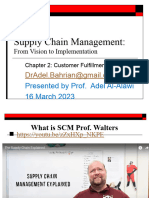0 ratings0% found this document useful (0 votes)
103 viewsManaging Different Stages of CRM: Dr. Savita Sharma
The document discusses various stages of customer relationship management including customer acquisition, retention, and lifetime value. It describes strategies for acquiring and retaining customers such as targeting the right audience, using video content, and offering good customer service. Metrics for measuring customer satisfaction, sales, marketing and service are also provided. Different loyalty programs and how to calculate customer lifetime value are outlined as well.
Uploaded by
Shaurya VirmaniCopyright
© © All Rights Reserved
Available Formats
Download as PPTX, PDF, TXT or read online on Scribd
0 ratings0% found this document useful (0 votes)
103 viewsManaging Different Stages of CRM: Dr. Savita Sharma
The document discusses various stages of customer relationship management including customer acquisition, retention, and lifetime value. It describes strategies for acquiring and retaining customers such as targeting the right audience, using video content, and offering good customer service. Metrics for measuring customer satisfaction, sales, marketing and service are also provided. Different loyalty programs and how to calculate customer lifetime value are outlined as well.
Uploaded by
Shaurya VirmaniCopyright
© © All Rights Reserved
Available Formats
Download as PPTX, PDF, TXT or read online on Scribd
You are on page 1/ 28
Module 04
Managing Different Stages of CRM
Dr. Savita Sharma
Customer Acquisition:
• It refers to gaining new customers.
• Acquisition costs of customers are those, that are
involved in influencing a potential customer to buy
the company’s product or service.
• It includes the research cost, marketing cost, and
accessibility cost of the particular product.
Customer Acquisition Strategies:
Define Your Target Audience
Use the Right Acquisition Channel
Leverage Video Content
Do Giveaways
Create High-Quality Content Regularly
Focus on SEO
Run a Referral Program
Create Optimized Landing Pages
Customer Retention Strategies:
Offer customer service “surprises”
Set customer expectations.
Build trust through relationships.
Use automation to re-engage customers.
Improve KPIs around customer service.
Leverage customer feedback surveys.
Develop a frequent communication calendar.
Over deliver on your promise.
CRM tools for Customer Retention:
Campaign Management Software: It tracks the up-
selling and cross-selling campaigns and their
effectiveness in terms of profit margins.
Data Mining: It helps in preparing customized offers by
referring to the stored transaction history of customers
and suggesting probability of what customer might buy.
Event-based Marketing: It helps to send offers to the
customers when an important event is triggered. For
example: a bank sends its customer the interest rates on
fixed deposit on opening a savings account with a bank.
Cont…
Channel Integration: It helps to manage working of
various communication channels harmoniously to avoid
creating and sending different customized offer for the
same product and customer.
Market Optimizing Software: It enables marketers to
manage their campaigns across various customer
segments, handle budget constraints, track various costs,
etc.
The add-on-selling:
Improve opportunities to increase sales by adding
related products as suggestions for up-sell, cross-
sell, accessories, or substitutes.
These related products are displayed as suggestions
to customers.
Defining related products will help your customers
to purchase more.
Customer Equity:
Customer equity is a result of customer relationship
management.
The theory of Customer Equity can be defined as the
value of the potential future revenue generated by a
company’s customers in the entire lifetime of the firm.
Customer Equity represents the value that current and
future potential customers will provide to a company
during the entire lifespan of their relationship.
It is also quite important because it incorporates many
other measures important to the marketing team of the
firm and presents it as a point measure or as a
probability distribution.
Customer Metrics:
Customer metrics are techniques for measuring the
value of customers to the company and company’s value
to them.
It include factors such as customer satisfaction and
loyalty measurements that are known to correlated with
revenue growth and margin improvement.
It tracks the performance of the company.
It gives a better control over sales and marketing.
Departments that are most associated with the influence
of CRM systems are Sales, Marketing and Service.
Sales:
Number of prospects
Number of new customers
Number of retained customers
Close rate
Renewal rate
Number of sales calls made
Number of sales calls per opportunity
Amount of new revenue
Number of open opportunities
Sales stage duration
Sales cycle duration
Number of proposals given
Marketing:
Number of campaigns
Number of campaign responses
Number of campaign purchases
Revenue generated by campaign
Number of new customers acquired by campaign
Number of customer referrals
Number of web page views
User goal completion rate on the web
Time per website visit
Customer lifetime value
Cross-sell ration
Up-sell ratio
Email list growth rate
Service:
Number of cases handled
Number of cases closed the same day
Average time to resolution
Average number of service calls per day
Complaint time to resolution
Number of customer call backs
Average service cost per service interaction
Percentage compliance with SLAs
Calls lost before being answered
Average call handling time
Summary:
Net promoter Score: A measure of how likely a
customer is to recommend your business to their
friends.
Customer Profitability: A measure of how much profit
a customer (or group of customers) are making the
business.
Customer Retention: Measures the loyalty, or how
successful you are retaining your existing customers.
Conversion Rate: Measures how well you are turning
prospects into actual customers.
Relative Market Share: Measures your share of
customer market relative to your competitors.
Customer Loyalty:
It is important because – Revenue, Referrals,
Acquisition cost is always higher than retention cost.
Customer loyalty measures how likely customers are
to return and their willingness to perform partner
shipping activities for the organization.
Customer satisfaction is a requisite for loyalty.
A loyalty program typically involves giving customers
free merchandise, early access to sales, products and
coupons. Loyalty programs have been proven to be
extremely successful in driving repeat sales for
brands.
Benefits:
Continued patronage
Reduced marketing costs
Decreased price sensitivity
Partnership activities
Leads to an increased Average Order Value (AOV)
Types of Loyalty Program:
1-Point-Based Loyalty Program
This is the simplest and most common loyalty program model where customers
earn a specific amount of points for every transaction or specific action. These
points can then be redeemed for discounts, products or services.
2-Tier-Based Loyalty Program
A tiered loyalty program works to provide both short term rewards and long term,
aspirational benefits once a customer reaches a specific level.
3-Fee-Based Loyalty Program
A fee-based loyalty program appeals to highly engaged customers who have
already made up their mind what they want out of your loyalty program. For fee-
based loyalty programs to be effective, it needs to offer a very relevant value
proposition to the customer whether it’s in form of free shipping, special discounts
or priority access to sales
Cont…
4-Cashback Loyalty Program
Cashback programs are simple and straightforward - spend
X amount and get Y amount as cashback. They have been
effective in reducing customer churn rates in a variety of
industries like retail, banking and insurance.
5-Reward Loyalty Program
Also known as a coalition loyalty program, this type of
program involves a brand partnering with another brand to
offer rewards and incentives to a shared group of
customers.
Customer Life Time Value:
CLTV is a prediction of all the value a business will derive
from their entire relationship with a customer.
20% of your customers generate 80% of revenue.
Because we don’t know how long each relationship will
be, we make a good estimate and state CLV as periodic
value.
Rather than thinking about how you can acquire a lot of
customers and how cheaply you do so…. CLTV helps you
think about how to optimize your acquisition spending
for maximum value rather than minimum cost.
CLTV:
Generate real ROI on customer acquisition
Enhance your retention marketing strategy
Create more effective messaging, targeting and nurturing
Improve your behavioral triggers
Improve output from customer support
How to calculate CLV:
P: Profit generated by customer each year
N: Number of years that they are a customer of the brand
C: Cost to acquire the customer
CLV = PxN-C
Measuring Customer Satisfaction:
• Customer satisfaction is a measure of how products
and/or services supplied by a company meet or surpass
customer expectation.
• It is also a key performance indicator (measure) within
business and is often part of the Balanced Scorecard.
• Delighted customers/clients are profitable on every
company business.
• It can be used as a basis of monitoring, evaluating and
developing new products and process that contribute to
company’s performance management.
Purpose of Customer Satisfaction:
1. The collection, analysis and dissemination of CS data send a
message about the importance of tending to customers and
ensuring that they have a positive experience with the
company’s goods and services.
2. Satisfaction is perhaps the best indicator of how likely it is
that the organizations’ customers will make further purchases
in the future. Since current research has now focusing on the
relationship between customer satisfaction and retention.
Methods in managing customer satisfaction:
Two ways: Direct method and Indirect method
Direct Method: Directly contacting customers and getting
their valuable feedback is very important. Following are
some ways by which they can be contacted:
a) Getting customer feedback through third party agencies.
b) Direct marketing, in-house call centres, complaint
handling department could be treated as first point of
contact.
c) Getting customer feedback through face to face
conversation or meeting.
d) Feedback through appreciation letter.
e) Feedback through surveys and questionnaires.
Methods in managing customer satisfaction:
Indirect Method: Following are indirect methods of getting
feedback regarding customer satisfaction.
a) Customer complaint: Customer’s complaints are the issues and
problems reported by the customer to supplier with regards to ant
specific product or related service. These complaints can be
classified under different segments according to the severity and
department.
b) Customer Loyalty: A customer is said to be loyal if he revisits
supplier on regular basis for purchases. These loyal customers are
the satisfied ones and hence they are bounded with a relationship
with the supplier. Hence by obtaining the customer loyalty index,
supplier can indirectly measure customer satisfaction.
Conflict Management:
It is a serious disagreement or argument, typically a
protracted one. It could be a fight, a battle or struggle,
especially a prolonged struggle; strif.
Opposition arising from disagreements due to
inconsistent objectives, thoughts, or emotions within or
among individuals, teams, departments or
organizations.
All unresolved conflict decreases productivity and
lowers performance.
To manage the conflicts in the organization is termed as
conflict management.
Types of conflict:
Goal conflict
Cognitive conflict
Affective conflict
Conflict Management Style:
Avoidance
Smoothing
Forcing
Compromise
collaborative
Customer Complaint Management:
An expression of dissatisfaction made to an
organization, related to its product or services, or the
complaints-handling process itself, where a response or
resolution is explicitly or implicitly expected.
Why do customers complain?
- Their expectations have not been met.
- To release their anger.
- To help improve the service.
- Because of concern for others who also use the service.
How do we handle customer complaint?
Listen
Repeat
Apologize
Acknowledge
Explain action
Thank
Follow up
Remember not to it personally
Remain calm
Focus on the problem and not person
Turn unhappy people into happy customers
Questions?
You might also like
- SOWBHAGYA - Interim Report - Research Project Report TemplateNo ratings yetSOWBHAGYA - Interim Report - Research Project Report Template24 pages
- E-Commerce Capstone Project PresentationNo ratings yetE-Commerce Capstone Project Presentation26 pages
- Clustering Analysis: Prepared by Muralidharan N100% (1)Clustering Analysis: Prepared by Muralidharan N16 pages
- Sample - Customer Churn Prediction Python DocumentationNo ratings yetSample - Customer Churn Prediction Python Documentation33 pages
- Data Science & Business Analytics: Post Graduate Program inNo ratings yetData Science & Business Analytics: Post Graduate Program in16 pages
- SMT Capstone PPT Ayushi Rastogi PGPDSBA.O.MAY22.CNo ratings yetSMT Capstone PPT Ayushi Rastogi PGPDSBA.O.MAY22.C12 pages
- Time Series Forecasting - Sparkling - Buisness ReportNo ratings yetTime Series Forecasting - Sparkling - Buisness Report70 pages
- Market Segmentation - Product Service ManagementNo ratings yetMarket Segmentation - Product Service Management16 pages
- Mra Project - Milestone1: Student Name: Gowri Srinivasan Batch: Dsba Online Mar 20No ratings yetMra Project - Milestone1: Student Name: Gowri Srinivasan Batch: Dsba Online Mar 2030 pages
- Business Report: Advanced Statistics Module Project - IINo ratings yetBusiness Report: Advanced Statistics Module Project - II9 pages
- House Price Prediction Using Data ScienceNo ratings yetHouse Price Prediction Using Data Science8 pages
- Assignment 5 - Heuristics and PrinciplesNo ratings yetAssignment 5 - Heuristics and Principles4 pages
- Capstone Project ON Impact of Quality Management Systems On Performance of A Company (Automobile Sector)No ratings yetCapstone Project ON Impact of Quality Management Systems On Performance of A Company (Automobile Sector)49 pages
- A Project Report On Customer Churn Rate in Axis Bank HubliNo ratings yetA Project Report On Customer Churn Rate in Axis Bank Hubli74 pages
- An Introduction To Clustering and Different Methods of ClusteringNo ratings yetAn Introduction To Clustering and Different Methods of Clustering9 pages
- Business Report On Data Mining: By: Aditya Janardan Hajare Batch: PGPDSBA Mar'C21 Group 1No ratings yetBusiness Report On Data Mining: By: Aditya Janardan Hajare Batch: PGPDSBA Mar'C21 Group 118 pages
- Machine Learning - Customer Segment Project. Approved by UDACITY100% (1)Machine Learning - Customer Segment Project. Approved by UDACITY19 pages
- Social Media Tourism - Capstone ProjectNo ratings yetSocial Media Tourism - Capstone Project13 pages
- Finance Risk Analytics - Priyanka Sharma - Business ReportNo ratings yetFinance Risk Analytics - Priyanka Sharma - Business Report49 pages
- Creating Customer Value, Satisfaction and Loyalty 2022100% (1)Creating Customer Value, Satisfaction and Loyalty 202237 pages
- SAP PLM CR EIA649C Configuration Change ExcerptsNo ratings yetSAP PLM CR EIA649C Configuration Change Excerpts11 pages
- Lesson 2 Updates in Financial Reporting StandardsNo ratings yetLesson 2 Updates in Financial Reporting Standards17 pages
- 2017 Programs For DILG Personnel - HRDDNo ratings yet2017 Programs For DILG Personnel - HRDD22 pages
- Instant Ebooks Textbook (Ebook PDF) Supply Chain Logistics Management 5th Edition by Donald Bowersox Download All Chapters100% (1)Instant Ebooks Textbook (Ebook PDF) Supply Chain Logistics Management 5th Edition by Donald Bowersox Download All Chapters41 pages
- MMA 2023-149 NoA of ISO Standard On Public TransportNo ratings yetMMA 2023-149 NoA of ISO Standard On Public Transport2 pages
- En 01 Job Title - Finance and Administrative Officer JD Iccrom 2024No ratings yetEn 01 Job Title - Finance and Administrative Officer JD Iccrom 20243 pages
- Top Warehousing Company in India - Ark IndiaNo ratings yetTop Warehousing Company in India - Ark India11 pages
- Purchase Order: Odicea Distribution Technologies Pvt. LTDNo ratings yetPurchase Order: Odicea Distribution Technologies Pvt. LTD1 page
- The 12 Agile Project Management PrinciplesNo ratings yetThe 12 Agile Project Management Principles4 pages
- Seatwork Transfer Pricing For BBF BSA 3206 Strategic Business AnalysisNo ratings yetSeatwork Transfer Pricing For BBF BSA 3206 Strategic Business Analysis9 pages
- ASQ Presentation On Process Capability Final 02 Feb 2016No ratings yetASQ Presentation On Process Capability Final 02 Feb 201680 pages
- Strategy Management Report in Shanghai Jing An Shangri La HotelNo ratings yetStrategy Management Report in Shanghai Jing An Shangri La Hotel20 pages
- What Are Some of The Limitations of Periodic, Manual, and Sample-Based Audits?No ratings yetWhat Are Some of The Limitations of Periodic, Manual, and Sample-Based Audits?2 pages
- SOWBHAGYA - Interim Report - Research Project Report TemplateSOWBHAGYA - Interim Report - Research Project Report Template
- Sample - Customer Churn Prediction Python DocumentationSample - Customer Churn Prediction Python Documentation
- Data Science & Business Analytics: Post Graduate Program inData Science & Business Analytics: Post Graduate Program in
- Time Series Forecasting - Sparkling - Buisness ReportTime Series Forecasting - Sparkling - Buisness Report
- Mra Project - Milestone1: Student Name: Gowri Srinivasan Batch: Dsba Online Mar 20Mra Project - Milestone1: Student Name: Gowri Srinivasan Batch: Dsba Online Mar 20
- Business Report: Advanced Statistics Module Project - IIBusiness Report: Advanced Statistics Module Project - II
- Capstone Project ON Impact of Quality Management Systems On Performance of A Company (Automobile Sector)Capstone Project ON Impact of Quality Management Systems On Performance of A Company (Automobile Sector)
- A Project Report On Customer Churn Rate in Axis Bank HubliA Project Report On Customer Churn Rate in Axis Bank Hubli
- An Introduction To Clustering and Different Methods of ClusteringAn Introduction To Clustering and Different Methods of Clustering
- Business Report On Data Mining: By: Aditya Janardan Hajare Batch: PGPDSBA Mar'C21 Group 1Business Report On Data Mining: By: Aditya Janardan Hajare Batch: PGPDSBA Mar'C21 Group 1
- Machine Learning - Customer Segment Project. Approved by UDACITYMachine Learning - Customer Segment Project. Approved by UDACITY
- Finance Risk Analytics - Priyanka Sharma - Business ReportFinance Risk Analytics - Priyanka Sharma - Business Report
- Creating Customer Value, Satisfaction and Loyalty 2022Creating Customer Value, Satisfaction and Loyalty 2022
- Instant Ebooks Textbook (Ebook PDF) Supply Chain Logistics Management 5th Edition by Donald Bowersox Download All ChaptersInstant Ebooks Textbook (Ebook PDF) Supply Chain Logistics Management 5th Edition by Donald Bowersox Download All Chapters
- MMA 2023-149 NoA of ISO Standard On Public TransportMMA 2023-149 NoA of ISO Standard On Public Transport
- En 01 Job Title - Finance and Administrative Officer JD Iccrom 2024En 01 Job Title - Finance and Administrative Officer JD Iccrom 2024
- Purchase Order: Odicea Distribution Technologies Pvt. LTDPurchase Order: Odicea Distribution Technologies Pvt. LTD
- Seatwork Transfer Pricing For BBF BSA 3206 Strategic Business AnalysisSeatwork Transfer Pricing For BBF BSA 3206 Strategic Business Analysis
- ASQ Presentation On Process Capability Final 02 Feb 2016ASQ Presentation On Process Capability Final 02 Feb 2016
- Strategy Management Report in Shanghai Jing An Shangri La HotelStrategy Management Report in Shanghai Jing An Shangri La Hotel
- What Are Some of The Limitations of Periodic, Manual, and Sample-Based Audits?What Are Some of The Limitations of Periodic, Manual, and Sample-Based Audits?

























































































